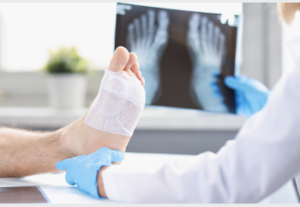Your feet are incredibly important to the way that you live your life. That’s why it’s important to see The-SA-Podiatry-Clinic podiatrist Adelaide for foot and ankle concerns.
Heel pain, bunions, recurring fungal infections or sports injuries are just a few reasons to visit your local podiatrist. Taking the right steps early on can help you avoid more serious issues in the future.
Plantar Fasciitis
 When the plantar fascia, which supports your heel arch, becomes overly tight or damaged, you may experience pain in the bottom of your foot. It can make standing or walking painful. Usually, the pain is most severe with your first steps in the morning or after prolonged sitting, then subsides as you walk and stretch out your heel and arch.
When the plantar fascia, which supports your heel arch, becomes overly tight or damaged, you may experience pain in the bottom of your foot. It can make standing or walking painful. Usually, the pain is most severe with your first steps in the morning or after prolonged sitting, then subsides as you walk and stretch out your heel and arch.
If you have persistent heel pain, especially from activities that pound the feet, like running or step aerobics, it is a good idea to see a podiatrist. They will evaluate your symptoms and may perform x-rays or other imaging tests to rule out other problems with the foot.
Your podiatrist will suggest a treatment plan that often includes physical therapy. Physical therapy can help you learn how to exercise and stretch your plantar fascia correctly. It can also include a gait assessment to identify imbalances that contribute to your pain. They may also recommend shoe modifications or surgery to relieve your pain if other treatments do not provide relief. Click here to find a podiatrist near you.
Bunions
Bunions (also known as hallux valgus) are a painful foot condition that occurs when the big toe bends towards the other toes. It’s a bony deformity that can lead to other health issues if left untreated. A podiatrist can provide treatment options, including shoe recommendations, taping, cushioning, medication or surgery in severe cases.
A bunion causes pain and discomfort, especially when you’re active. It can even limit your mobility, making it difficult to reach your fitness goals.
It’s more common in women, primarily because they typically wear shoes that are too tight and have pointed toes. While wearing tight shoes isn’t the main cause of a bunion, it does make it get worse more quickly.
Athlete’s Foot
An athlete’s foot (technically tinea pedis) is a fungal infection that causes a red or itchy rash on the soles of your feet or in between your toes. It can cause a thick, scaly appearance and may have an unpleasant odour. The infection can also lead to blisters and cracked, swollen skin.
The fungus can spread from one person to another through direct contact, such as rubbing feet together or sharing shoes or towels. It can also spread indirectly by coming into contact with contaminated surfaces, such as public showers or locker rooms.
Treatment for athlete’s foot involves medicated creams, sprays or powders that contain antifungal agents such as clotrimazole and terbinafine. These products can be purchased over the counter or with a prescription from a podiatrist.
It’s important to use the medicine correctly to get rid of the fungus that causes your symptoms. Your podiatrist will provide specific instructions for use, and you should follow these instructions closely to ensure your condition gets better. Also, avoid walking barefoot in public places or wearing shoes that don’t fit you well.
Calluses and Corns
Corns and calluses form when repeated friction or pressure causes a buildup of thick skin. It can happen in the hands or feet. Mild corns and calluses may not cause pain or need treatment. More serious ones can be painful and can lead to infections. They can also affect the ability to walk or perform daily activities.
The-SA-Podiatry-Clinic podiatrist Adelaide will usually diagnose them by examining the area and asking about your lifestyle. They will ask about the type of shoes you wear and what physical activity you participate in. They can recommend padding, shoe inserts or metatarsal bars to redistribute pressure away from the area of the lesion. Surgery is rarely used to treat calluses and corns unless the bone structure is altered by structural foot conditions such as bunions or hammertoes.